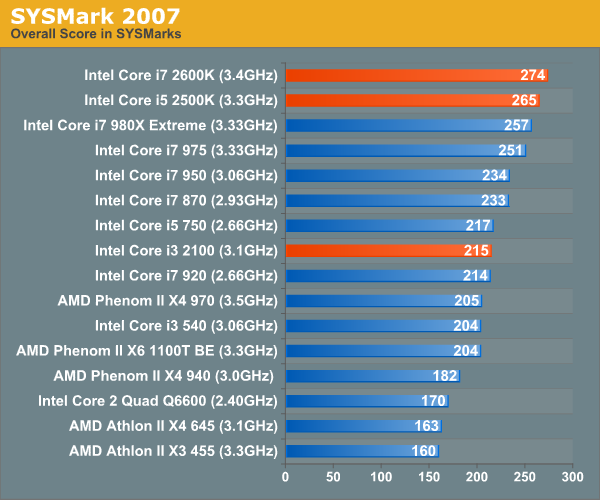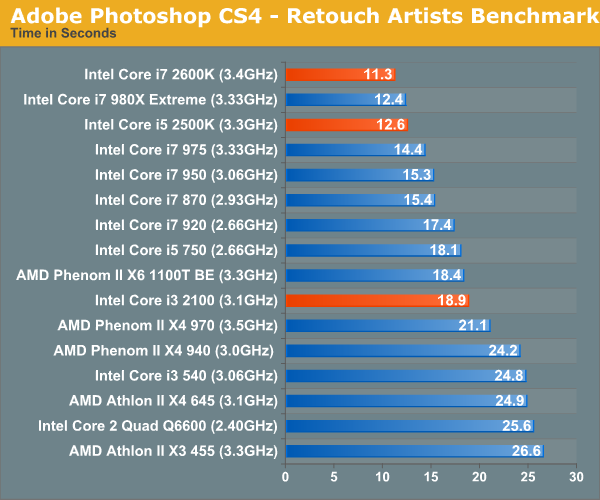The Sandy Bridge Review: Intel Core i7-2600K, i5-2500K and Core i3-2100 Tested
by Anand Lal Shimpi on January 3, 2011 12:01 AM ESTGeneral Performance: SYSMark 2007
Our journey starts with SYSMark 2007, the only all-encompassing performance suite in our review today. The idea here is simple: one benchmark to indicate the overall performance of your machine. SYSMark 2007 ends up being more of a dual-core benchmark as the applications/workload show minimal use of more than two threads.

The 2600K is our new champion, the $317 chip is faster than Intel's Core i7 980X here as SYSMark 2007 doesn't really do much with the latter's extra 2 cores. Even the 2500K is a hair faster than the 980X. Compared to the Core i5 750, the upgrade is a no brainer - Sandy Bridge is around 20% faster at the same price point as Lynnfield.
Compared to Clarkdale, the Core i3 2100 only manages a 5% advantage howeer.
Adobe Photoshop CS4 Performance
To measure performance under Photoshop CS4 we turn to the Retouch Artists’ Speed Test. The test does basic photo editing; there are a couple of color space conversions, many layer creations, color curve adjustment, image and canvas size adjustment, unsharp mask, and finally a gaussian blur performed on the entire image.
The whole process is timed and thanks to the use of Intel's X25-M SSD as our test bed hard drive, performance is far more predictable than back when we used to test on mechanical disks.
Time is reported in seconds and the lower numbers mean better performance. The test is multithreaded and can hit all four cores in a quad-core machine.

Once again, we have a new king - the 2600K is 9.7% faster than the 980X in our Photoshop CS4 test and the 2500K is just about equal to it. The Core i3 2100 does much better compared to the i3 540, outpacing it by around 30% and nearly equaling the performance of AMD's Phenom II X6 1100T.










283 Comments
View All Comments
DanNeely - Monday, January 3, 2011 - link
The increased power efficiency might allow Apple to squeeze a GPU onto their smaller laptop boards without loosing runtime due to the smaller battery.yuhong - Monday, January 3, 2011 - link
"Unlike P55, you can set your SATA controller to compatible/legacy IDE mode. This is something you could do on X58 but not on P55. It’s useful for running HDDERASE to secure erase your SSD for example"Or running old OSes.
DominionSeraph - Monday, January 3, 2011 - link
"taking the original Casino Royale Blu-ray, stripping it of its DRM"Whoa, that's illegal.
RussianSensation - Monday, January 3, 2011 - link
It would have been nice to include 1st generation Core i7 processors such as 860/870/920-975 in Starcraft 2 bench as it seems to be very CPU intensive.Also, perhaps a section with overclocking which shows us how far 2500k/2600k can go on air cooling with safe voltage limits (say 1.35V) would have been much appreciated.
Hrel - Monday, January 3, 2011 - link
Sounds like this is SO high end it should be the server market. I mean, why make yet ANOTHER socket for servers that use basically the same CPU's? Everything's converging and I'd just really like to see server mobo's converge into "High End Desktop" mobo's. I mean seriously, my E8400 OC'd with a GTX460 is more power than I need. A quad would help with the video editing I do in HD but it works fine now, and with GPU accelerated rendering the rendering times are totally reasonable. I just can't imagine anyone NEEDING a home computer more powerful than the LGS-1155 socket can provide. Hell, 80-90% of people are probably fine with the power Sandy Bridge gives in laptops now.mtoma - Monday, January 3, 2011 - link
Perhaps it is like you say, however it's always good for buyers to decide if they want server-like features in a PC. I don't like manufacturers to dictate to me only one way to do it (like Intel does now with the odd combination of HD3000 graphics - Intel H67 chipset). Let us not forget that for a long time, all we had were 4 slots for RAM and 4-6 SATA connections (like you probably have). Intel X58 changed all that: suddenly we had the option of having 6 slots for RAM, 6-8 SATA connections and enough PCI-Express lanes.I only hope that LGA 2011 brings back those features, because like you said: it's not only the performance we need, but also the features.
And, remeber that the software doesn't stay still, it usualy requires multiple processor cores (video transcoding, antivirus scanning, HDD defragmenting, modern OS, and so on...).
All this aside, the main issue remains: Intel pus be persuaded to stop luting user's money and implement only one socket at a time. I usually support Intel, but in this regard, AMD deserves congratulations!
DanNeely - Monday, January 3, 2011 - link
LGA 2011 is a high end desktop/server convergence socket. Intel started doing this in 2008, with all but the highest end server parts sharing LGA1366 with top end desktop systems. The exception was quad/octo socket CPUs, and those using enormous amounts of ram using LGA 1567.The main reason why LGA 1155 isn't suitable for really high end machines is that it doesn't have the memory bandwidth to feed hex and octo core CPUs. It's also limited to 16 PCIe 2.0 lanes on the CPU vs 36 PCIe 3.0 lanes on LGA2011. For most consumer systems that won't matter, but 3/4 GPU card systems will start loosing a bit of performance when running in a 4x slot (only a few percent, but people who spend $1000-2000 on GPUs want every last frame they can get), high end servers with multiple 10GB ethernet cards and PCIe SSD devices also begin running into bottlenecks.
Not spending an extra dollar or five per system for the QPI connections only used in multi-socket systems in 1155 also adds up to major savings across the hundreds of millions of systems Intel is planning to sell.
Hrel - Monday, January 3, 2011 - link
I'm confused by the upset over playing video at 23.967hz. "It makes movies look like, well, movies instead of tv shows"? What? Wouldn't recording at a lower frame rate just mean there's missed detail especially in fast action scenes? Isn't that why HD runs at 60fps instead of 30fps? Isn't more FPS good as long as it's played back at the appropriate speed? IE whatever it's filmed at? I don't understand the complaint.On a related note hollywood and the world need to just agree that everything gets recorded and played back at 60fps at 1920x1080. No variation AT ALL! That way everything would just work. Or better yet 120FPS and with the ability to turn 3D on and off as u see fit. Whatever FPS is best. I've always been told higher is better.
chokran - Monday, January 3, 2011 - link
You are right about having more detail when filming with higher FPS, but this isn't about it being good or bad, it's more a matter of tradition and visual style.The look movies have these days, the one we got accustomed to, is mainly achieved by filming it in 24p or 23.967 to be precise. The look you get when filming with higher FPS just doesn't look like cinema anymore but tv. At least to me. A good article on this:
http://www.videopia.org/index.php/read/shorts-main...
The problem with movies looking like TV can be tested at home if you got a TV that has some kind of Motion Interpolation, eg. MotionFlow called by Sony or Intelligent Frame Creation by Panasonic. When turned on, you can see the soap opera effect by adding frames. There are people that don't see it and some that do and like it, but I have to turn it of since it doesn't look "natural" to me.
CyberAngel - Thursday, January 6, 2011 - link
http://en.wikipedia.org/wiki/Showscan